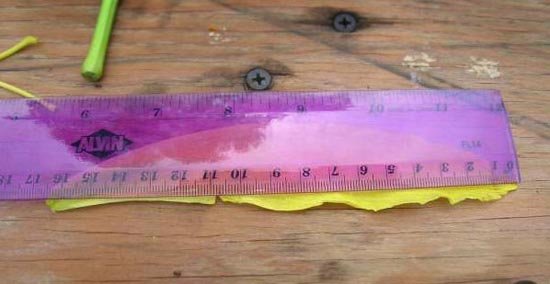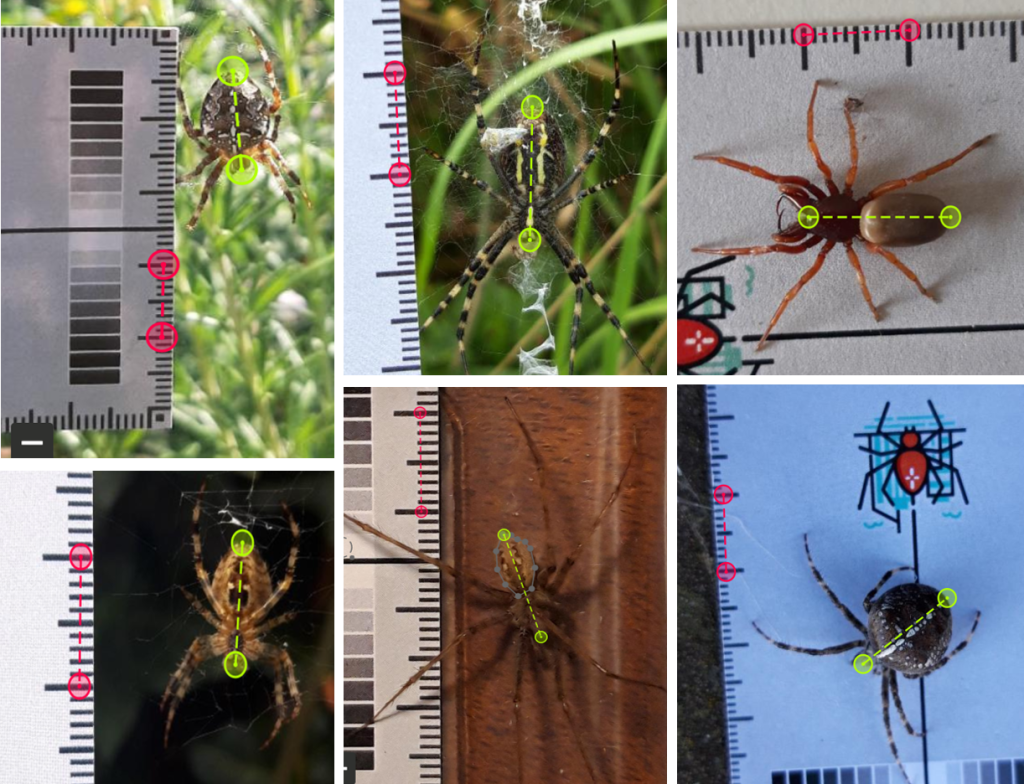Have you ever wondered how scientists measure the size of spiders? In this article, we will explore the various methods used by researchers to accurately determine the dimensions of these eight-legged creatures. From leg span measurements to body length calculations, we will discover the fascinating techniques employed in the field of arachnology. So, put on your investigative hat and get ready to unravel the mystery of measuring the size of a spider!
Methods for Measuring the Size of a Spider
Spiders come in a wide variety of shapes and sizes, and measuring their size accurately can be quite an interesting task. There are several methods you can use to measure the size of a spider, each with its pros and cons. In this article, we will explore different techniques, ranging from direct measurement to optical instruments, to help you determine the size of these fascinating arachnids.

This image is property of fearnottarantulas.zendesk.com.
Using Direct Measurement
Direct measurement involves physically measuring various parts of the spider’s body to determine its size. This method is straightforward and provides precise measurements.
Measuring Body Length
To measure a spider’s body length, place the spider on a flat surface and gently straighten its legs. Use a ruler or tape measure to measure the distance from the front of the spider’s cephalothorax (head and thorax) to the tip of its abdomen.
Measuring Leg Length
Leg length can be measured similarly to body length. Gently stretch out one of the spider’s legs and measure the distance from the body to the tip of the leg. Repeat this process for each leg and record the measurements.
Measuring Abdomen Size
To measure the size of a spider’s abdomen, use calipers to measure its width, height, and length. Carefully hold the spider and place the calipers on either side of the abdomen, recording the measurements.
Measuring Carapace Size
The carapace is the hard, shell-like structure that covers the spider’s cephalothorax. To measure the size of the carapace, use calipers or a ruler to measure its width and length. Some spiders may require gentle restraint during this process to prevent injury.
Using Comparative Sizing
Comparative sizing involves comparing the spider to objects or known reference sizes, providing a relative measurement of the spider’s size.
Comparing to Objects of Known Size
Find objects of known sizes, such as coins or small toys, and place them next to the spider for comparison. By observing how the spider compares in size to these objects, you can estimate its approximate size range.
Using Common References
Another way to gauge the size of a spider is by using common references. For example, you can compare the spider’s size to common insects like ants or flies. This method gives you a sense of whether the spider is smaller or larger than these familiar creatures.

This image is property of spidersfaq.com.
Using Scale Photographs
Scale photographs are useful when you want to capture the size of a spider in a visual form. This method allows for accurate measurements to be taken at a later time.
Photographing with a Scale Reference
When taking a photograph of a spider, include a reference object of known size in the picture. This could be a ruler, coin, or any item with easily identifiable measurements. Later, you can use this reference to calculate the spider’s size by comparing it to the known measurements.
Using Image Analysis Software
After taking scale photographs, you can use image analysis software to measure the size of the spider in the images. These software tools allow you to outline the spider’s body and calculate its dimensions accurately.
Using Web Measurements
If you’re dealing with a spider that spins a web, you can measure various aspects of the web to estimate the spider’s size.
Measuring Web Diameter
To measure the web’s diameter, use a ruler or tape measure to determine the distance across the center of the web. Make sure to measure at multiple points to get an average diameter.
Measuring Silk Strand Thickness
The thickness of the silk strands can give you an idea of the spider’s size. Use a microscope or magnifying glass to carefully examine the silk threads and estimate their diameter.
Calculating Web Area
The area covered by the spider’s web can also provide insights into its size. You can calculate this by estimating the length and width of the web and multiplying both measurements. This method gives you a rough estimate of the spider’s size based on the space it occupies with its web.

This image is property of daylilies.org.
Using Leg Spans
Measuring leg spans is a common method for determining the size of spiders. This approach provides a quick indication of a spider’s size.
Measuring Leg Spans with a Ruler
Gently extend the spider’s legs and measure the distance between the tips of the two longest legs using a ruler. This measurement gives you an estimate of the spider’s leg span.
Measuring Leg Spans with Calipers
For more precise measurements, use calipers to measure the leg span. Place the calipers at the widest points of the spider’s legs, taking care not to disturb or harm the spider.
Using Body Lengths
Measuring the spider’s body length directly can provide crucial information about its size.
Measuring Body Lengths with a Ruler
Align the ruler with the spider’s body from the tip of the cephalothorax to the end of the abdomen. Make sure to keep the ruler straight and measure in a way that doesn’t cause discomfort to the spider.
Measuring Body Lengths with Calipers
Calipers can be used to measure the spider’s body length in a more precise manner. Gently hold the spider and use the calipers to determine the distance from the cephalothorax to the tip of the abdomen.

This image is property of spidersfaq.com.
Using Weight
Measuring a spider’s weight gives you another perspective on its size. However, this method should be approached with caution to avoid harming the spider.
Weighing the Spider on a Scale
Place the spider in a small container and weigh the container on a sensitive scale. Subsequently, subtract the weight of the empty container to determine the spider’s weight. This method requires great care to ensure the spider’s safety.
Using Indirect Methods for Weight Estimation
If directly weighing the spider is not feasible or appropriate, you can estimate its weight indirectly. This can be done by comparing the spider to similar-looking spiders of known weight, making an informed estimate based on visual similarities.
Using Volume
Calculating the spider’s volume provides yet another dimension to its size exploration.
Calculating Volume by Water Displacement
For this method, place a container filled with water on a scale and record the weight. Carefully submerge the spider in the water, ensuring it remains unharmed. Measure the new weight of the container and spider together. Subtract the initial weight of the container from the combined weight to determine the spider’s weight. Considering the density of water, you can then calculate the spider’s approximate volume.
Calculating Volume by Mathematical Models
Mathematical models based on the spider’s dimensions, such as body length, leg span, and abdomen size, can be used to estimate its volume indirectly. These calculations rely on established relationships between size dimensions and volume.

This image is property of www.spinnenspotter.be.
Using Optical Instruments
Optical instruments provide powerful tools for precise measurements, especially when examining smaller details of the spider.
Utilizing Hand Lenses
Hand lenses, also known as magnifying glasses, are helpful for observing and measuring fine details of a spider’s body. By magnifying specific areas of the spider, you can obtain more accurate measurements of its size.
Using Microscopes
Light microscopes offer even higher magnification capabilities than hand lenses, ideal for studying minute features of a spider. By using microscopes, you can observe intricate details and obtain precise measurements, contributing to a more comprehensive understanding of the spider’s size.
Using Stereomicroscopes
Stereomicroscopes, also called dissecting microscopes, allow for a three-dimensional view of the spider. This type of microscope is particularly useful when studying the spider’s structure from various angles, providing detailed and accurate size measurements.
Using Scanning Electron Microscopes
At the highest level of magnification, scanning electron microscopes (SEM) allow for incredibly detailed observations of the spider’s surface. SEM images can help analyze fine structures and measure extremely small features, providing a deeper understanding of the spider’s size and morphology.
In conclusion, measuring the size of a spider encompasses various methods, each offering distinct advantages and insights. From direct measurements to comparative sizing, scale photographs, web measurements, leg spans, body lengths, weight, volume calculations, and optical instrument usage, these techniques provide a comprehensive toolkit for gauging the dimensions of these fascinating arthropods. Choose the method most suitable for your observation and remember to handle spiders with care while performing measurements to ensure their well-being.
